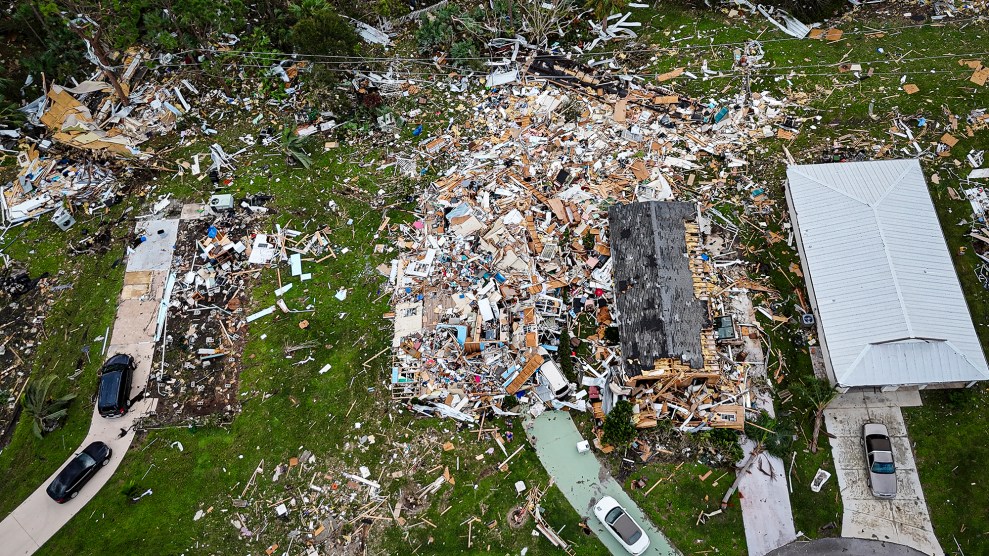The most destructive wildfires in California’s history have left at least 14 people dead, thousands of homes destroyed, and hundreds of thousands of people displaced. The fires have also left politicians and environmentalists speculating, a little late, on what can be done to avoid such devastation.
Pointing to the fires, some politicians say it’s past time to move forward with Bush’s “Healthy Forests” initiative, a policy awaiting legislative funding that, according to administration p.r., will minimize wildfires by thinning thousands of acres of national forests. Opponents say the initiative would have done nothing to prevent the fires in California, and that it’s opportunistic to put a rush on the legislation now.
At stake in congress is an allocation of $760 million a year to remove brush and diseased trees from more than 20 million acres of national forests, while allowing timber companies to take large trees from deep in the forests to cover the costs of thinning.
Environmentalists say the fire prevention claims made for “Healthy Forests” are just a cover for big giveaways to timber to industry loggers. Critics also worry that the bill doesn’t protect old growth forests or allow for environmental and citizen reviews before forest thinning begins. Those who live in fire-prone zones (who must be thinking a lot more than usual about this kind of thing right now) argue the bill doesn’t even protect those wildfire-susceptible areas we should be most concerned about: “red zones” that surround urban areas. An editorial in the Daily Camera has this to say:
“[T]he bill passed by the House of Representatives in May (and immediately hailed by the president) didn’t concentrate wildfire-mitigation in the red zones. On the other hand, the House version of the bill did provide inadequate protection of large-diameter, old-growth trees, which are not prone to burn. Furthermore, the House bill stripped environmental and citizen-review provisions on 20 million acres of forested land.”
Since the bill in congress focuses so little on the flammable brush surrounding urban areas, experts say the only way to prevent fires like the ones in California is by re-instituting the natural processes that keep wildfires from getting out of control. They say part of the problem is that people are choosing to live in natural tinderboxes. Because more and more residents are moving to the forested areas of California, the natural cycle of wildfires that keeps forests fruitful hasn’t been happening as it should.
The head of the U.S. Forest Service said Tuesday that unless prescribed burns are reintroduced in southern California, there’ll be more catastrophic fires in the future. Mike Davis writes of the problems that come from building homes in forested areas:
“The best preventive measure, of course, is to return to the native-Californian practice of regular, small-scale burning of old brush and chaparral. This is now textbook policy, but the suburbanization of the fire terrain makes it almost impossible to implement it on any adequate scale. Homeowners despise the temporary pollution of “controlled burns” and local officials fear the legal consequences of escaped fires.
As a result, huge plantations of old, highly flammable brush accumulate along the peripheries and in the interstices of new, sprawled-out suburbs. Since the devastating 1993 fires, tens of thousands of new homes have pushed their way into the furthest recesses of Southern California’s coastal and inland fire-belts.”
But the California fires have given some lawmakers leverage to argue for accelerated passage of the bill, claiming that environmentalists are irresponsibly stalling it. Bill Frist (R-Tenn) told reporters that “with the fires going on out West, I think we have a real responsibility to bring that legislation.”
Environmentalists argue that the issue of logging is moot in southern California, since the fires there are caused by thick underbrush, not the large, marketable trees at the center of the debates over the “Healthy Forest” initiative. Jay Watson of The Wilderness Society, told the L.A. Times that it’s an outrage to tie the California fires to the legislation, which would do little to protect that area:
“It’s searing in its ruthlessness and irresponsibility. The Healthy Forests initiative would have nothing to do with chaparral fires in Southern California, because no money is being made available to treat that or do brush removal near threatened communities.”
Legislation needs to focus on preventing wildfires where people live; “Healthy Forests,” says The Daily Camera, doesn’t do that.
“Fire in the forested wilderness is natural and necessary, but fire in rural human communities is unnatural and devastating. That proposition is so self-evident, everyone from the president to the Sierra Club accepts it.
So why won’t Congress concentrate wildfire-suppression on the areas that most urgently need protection?”
















